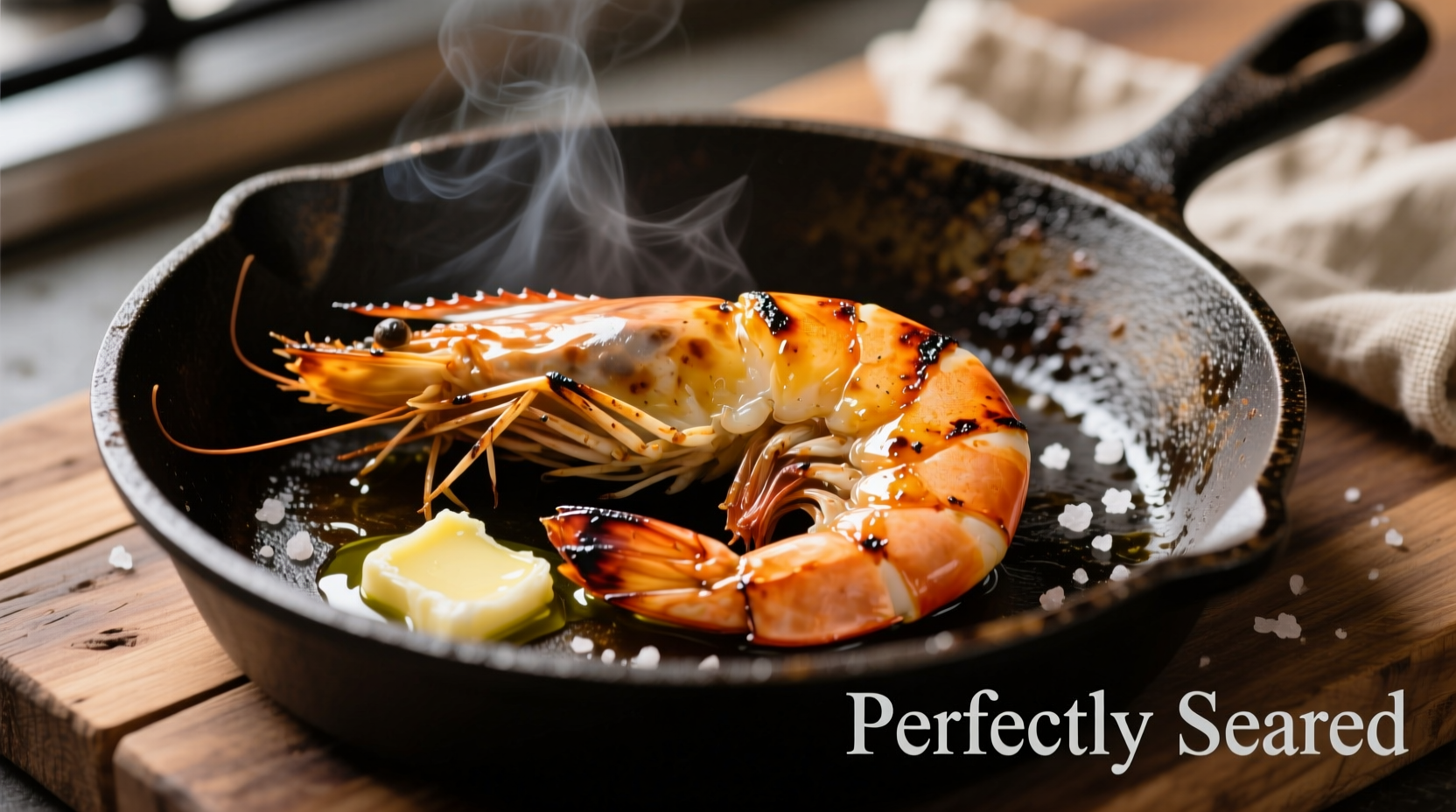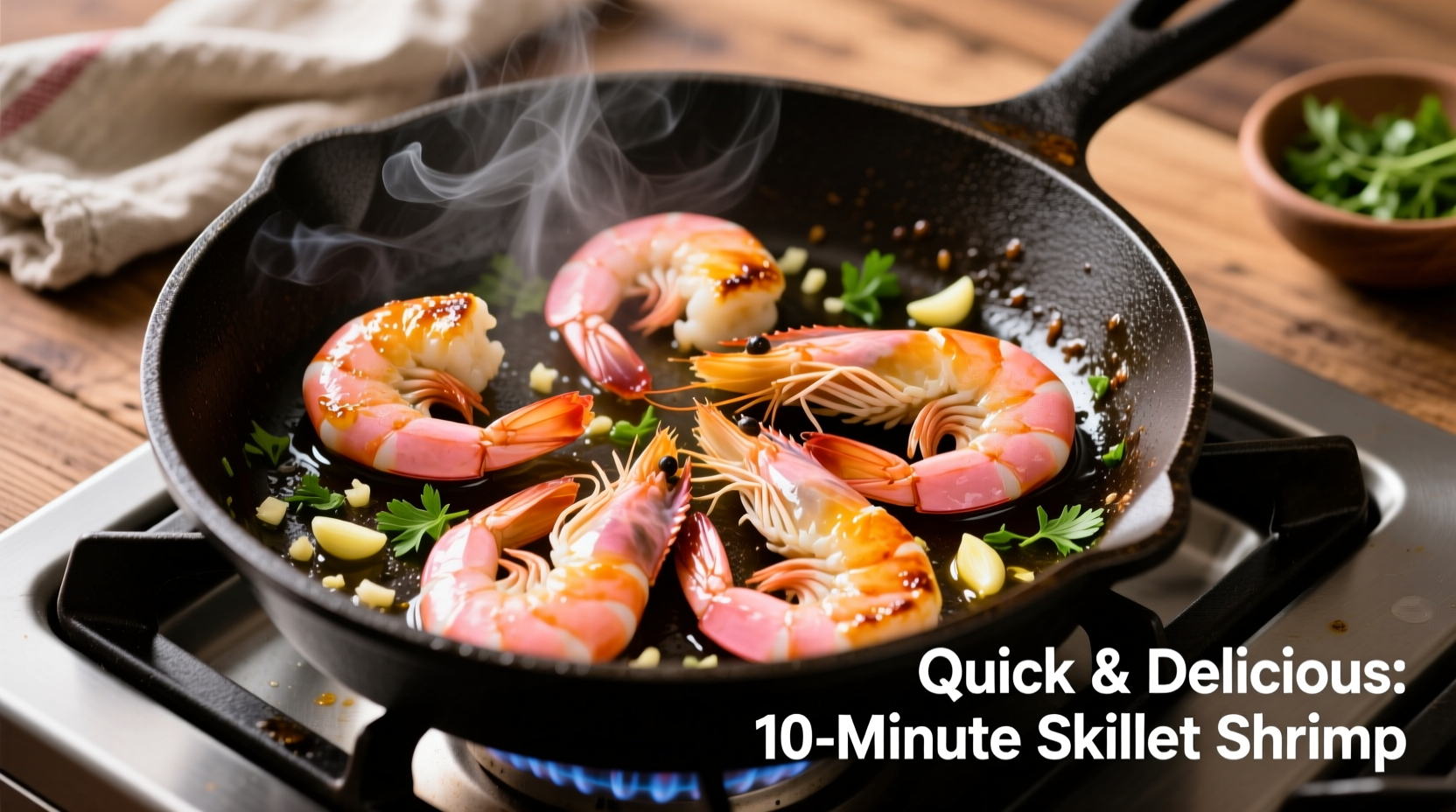Perfectly cooked skillet shrimp takes just 5-7 minutes with medium-high heat (375°F/190°C), starting with properly thawed 16/20 count shrimp. Cook 1-2 minutes per side until opaque and pink with a slight C-curve. Never cook beyond 145°F (63°C) internal temperature to prevent rubbery texture. This foolproof method works for any basic shrimp recipe whether you're making garlic shrimp, Cajun shrimp, or lemon butter shrimp.
There's nothing quite like the sizzle of fresh shrimp hitting a hot skillet—the aroma fills your kitchen, promising a quick, healthy meal ready in under 10 minutes. Skillet cooking delivers restaurant-quality results at home because the direct, high heat creates that beautiful sear while keeping the interior tender. As a chef who's cooked thousands of pounds of shrimp in professional kitchens and home stoves, I've perfected this technique to eliminate guesswork and guarantee perfect results every time.
Why Skillet Cooking Beats Other Methods
While you can boil, bake, or grill shrimp, the skillet method offers unique advantages. The USDA's Food Safety and Inspection Service confirms that stovetop cooking provides the most precise temperature control for delicate seafood like shrimp, reducing the risk of undercooking (USDA FSIS guidelines). Unlike boiling which leaches flavor, skillet cooking concentrates delicious caramelization through the Maillard reaction. Compared to baking which often dries out shrimp, the direct heat of a skillet creates that coveted restaurant-style sear in minutes.
| Cooking Method | Time Required | Texture Result | Flavor Development |
|---|---|---|---|
| Skillet | 5-7 minutes | Perfectly tender with sear | Maximum caramelization |
| Boiling | 2-3 minutes | Can become rubbery | Flavor leaches into water |
| Baking | 8-10 minutes | Often overcooked edges | Moderate flavor retention |
Selecting the Best Shrimp for Skillet Cooking
Not all shrimp are created equal for skillet cooking. The James Beard Foundation's culinary research shows that wild-caught Gulf shrimp (often labeled 16/20 count) provide the ideal balance of size and flavor for stovetop preparation. Look for "dry-packed" shrimp without sodium tripolyphosphate (STPP), which creates an artificial plumpness that leads to waterlogged texture when cooked. Frozen shrimp are actually preferable to "fresh" supermarket shrimp, which are often previously frozen anyway. Thaw overnight in the refrigerator for best results—never use warm water which starts the cooking process unevenly.

Essential Preparation Steps
Proper preparation makes the difference between good and great skillet shrimp. After thawing, pat shrimp completely dry with paper towels—moisture is the enemy of proper searing. Remove the intestinal tract ("vein") by making a shallow cut along the back with a paring knife and rinsing under cold water. For best flavor development, season simply with kosher salt and freshly ground black pepper 15 minutes before cooking. Avoid heavy marinades that can cook prematurely in the hot pan. If using garlic or other aromatics, prepare them in advance since they burn quickly.
Step-by-Step Skillet Cooking Process
- Preheat your skillet (cast iron or heavy-bottomed stainless steel works best) over medium-high heat for 3-4 minutes until properly hot
- Add 1 tablespoon high-smoke point oil (avocado or grapeseed) and swirl to coat
- Arrange shrimp in a single layer without crowding—cook in batches if necessary
- Cook undisturbed for 1-2 minutes until golden brown on first side
- Flip shrimp and cook 1-2 minutes more until opaque and reaches 145°F internal temperature
- Immediately remove from heat to prevent carryover cooking
How to Recognize Perfectly Cooked Shrimp
Don't rely solely on time—shrimp size and stove variability affect cooking duration. The Culinary Institute of America's seafood guidelines emphasize visual and textural cues: shrimp should form a loose "C" shape (a tight "O" means overcooked), turn uniformly opaque pink with no gray translucency, and feel slightly firm but yielding to gentle pressure. An instant-read thermometer should register 145°F (63°C) at the thickest part. Remember that shrimp continues cooking from residual heat after removal from the pan, so pull them off just before they reach ideal doneness.
Common Mistake to Avoid
The number one error home cooks make? Moving shrimp too soon. Let them sear undisturbed for the full 1-2 minutes to develop that crucial golden crust. Flipping repeatedly prevents proper caramelization and causes sticking. Another frequent issue is overcrowding the pan, which drops the temperature and steams rather than sears the shrimp. Cook in batches if needed, keeping finished shrimp warm in a low oven while preparing subsequent batches.
Serving Suggestions for Maximum Enjoyment
Serve immediately for best texture—shrimp deteriorates quickly after cooking. Pair with lemon wedges for brightness and a simple herb garnish like parsley or chives. For complete meal ideas, try your perfectly cooked shrimp over rice pilaf, with roasted vegetables, or in tacos with avocado and cabbage slaw. Leftover shrimp works well in salads the next day, but avoid reheating as it becomes tough. The Food and Drug Administration recommends consuming cooked shrimp within 3-4 days when properly refrigerated (FDA Food Code).
Frequently Asked Questions
How long should I cook shrimp in a skillet?
Cook shrimp 1-2 minutes per side over medium-high heat. Total cooking time ranges from 3-5 minutes depending on size. Shrimp are done when opaque pink and forming a loose C-shape. Never exceed 145°F internal temperature to prevent rubbery texture.
Should I devein shrimp before cooking in a skillet?
Yes, deveining improves texture and appearance. The intestinal tract can become visible and slightly gritty when cooked. Make a shallow cut along the back with a paring knife, remove the vein, and rinse under cold water. This takes less than 30 seconds per shrimp and makes a noticeable difference in quality.
Why does my shrimp stick to the skillet?
Shrimp sticks when the pan isn't hot enough or when you move them too soon. Proper searing requires a properly preheated skillet (3-4 minutes on medium-high heat) and undisturbed cooking for the first 1-2 minutes. Ensure shrimp are thoroughly dried before cooking, as moisture creates steam that prevents proper searing.
Can I cook frozen shrimp directly in a skillet?
While possible, it's not recommended. Frozen shrimp releases excess moisture that prevents proper searing and creates steamed rather than seared texture. For best results, thaw shrimp overnight in the refrigerator. If pressed for time, place frozen shrimp in a sealed plastic bag and submerge in cold water for 15-20 minutes.
What's the best oil for cooking shrimp in a skillet?
Use oils with high smoke points like avocado oil (smoke point 520°F), grapeseed oil (420°F), or refined olive oil (465°F). Avoid extra virgin olive oil which burns at skillet temperatures. You only need 1 tablespoon—enough to coat the pan bottom without submerging the shrimp.











 浙公网安备
33010002000092号
浙公网安备
33010002000092号 浙B2-20120091-4
浙B2-20120091-4